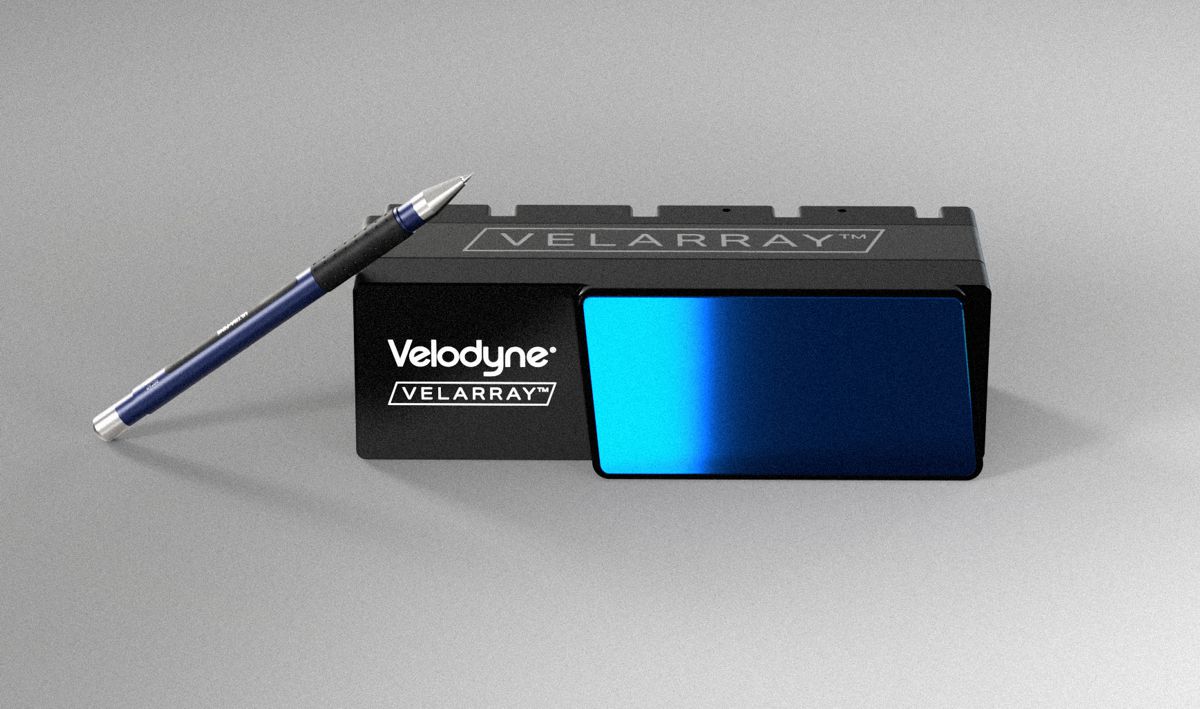Velodyne Lidar unveils breakthrough Velarray H800 micro-lidar array sensors
Velodyne Lidar has debuted its latest innovation in its broad array of lidar sensors, the Velarray H800. The solid state Velarray H800 is architected for automotive grade performance and built using Velodyne’s breakthrough proprietary micro-lidar array architecture (MLA).
With combined long-range perception and a broad field of view, this sensor is designed for safe navigation and collision avoidance in advanced driver assistance systems (ADAS) and autonomous mobility applications. The Velarray H800’s compact, embeddable form factor is designed to fit neatly behind the windshield of a truck, bus or car, or be mounted seamlessly on the vehicle exterior. The Velarray H800 will be available at high-volume production levels with a target price of less than $500 to drive broad adoption in consumer and commercial vehicle markets.
“Velodyne’s launch of the Velarray H800 lidar sensor, which is the first in a family of solid state lidars we will be releasing publicly, is important to automakers for three reasons,” said Anand Gopalan, Velodyne Lidar CEO. “First, the Velarray H800 was specifically designed for high volume automotive applications with feedback from leading OEM customers. It uses Velodyne’s global network of high-quality manufacturing partnerships that provide the high quantity automakers need. Second, Velodyne’s proprietary technology and experience, combined with our manufacturing capacity, allow us to offer the sensor at a price that makes economic sense for automakers. Third, the world needs enhanced safety in consumer vehicles and the Velarray product line makes that available to end consumers creating safer roadways and cars for all.”
The Velarray H800 can help automakers design ADAS solutions that help reduce traffic accidents as well as injuries and deaths of drivers, passengers, bicyclists and pedestrians. The World Health Organization reports that annual deaths caused by traffic crashes have reached 1.35 million globally.
“We want to help build the public’s trust in automated vehicle systems,” Marta Hall, Velodyne founder and CMO, commented. “We believe the Velarray H800 is the first of many lidar sensors that will be used in systems for powerful vehicle safety. Velodyne is introducing it as a key sensor for systems designed as building blocks for vehicle safety. Once the public experiences the benefits of reliable automated safety systems, they will welcome more products like this. We can save lives with ADAS.”
The Velarray H800 boasts outstanding range, field of view and resolution to support advancements in autonomy and ADAS, from Level 2 to Level 5. This spans the entirety of ADAS features from Lane Keep Assist and Automated Emergency Braking, all the way to the top levels of automated driving. The compact, low cost sensor can be paired with Velodyne’s Vella software suite, enabling the full spectrum of safety features.
The efficacy of lidar in creating robust and feature-rich ADAS has been acknowledged across the auto industry in the past few years. Proprietary testing indicated superiority of the Velarray-based solution where a traditional camera and radar system failed. Please see Velodyne’s recently issued white paper regarding Pedestrian Automatic Emergency Braking (PAEB) here.
With a field of view of 120 horizontal degrees by 16 vertical degrees, the Velarray H800 allows for outstanding detection of peripheral, near-field, and overhead objects while addressing corner cases on sloping and curving roads. The Velarray H800 provides perception data at a range of up to 200 meters, supporting safe stopping distances even at highway speeds. Featuring a configurable frame rate, the Velarray H800 offers the rich point cloud density required for high resolution mapping and object classification tasks.
Drawing on insights gained from going public, Gopalan commented, “During meetings with investors over the past several months, I have received many questions about Velodyne’s solid state roadmap. The fact is that Velodyne has offered solid state lidar sensors for more than two years, but we’ve used the term ‘directional’ sensors to describe Velodyne’s solid state lidar technology. With the introduction of the Velarray H800, we saw the opportunity to demonstrate how Velodyne’s lidar technology prowess spans many form factors and applications. Velodyne wants to improve roadway safety by making all vehicles smarter. That’s why we are working so hard to provide ADAS technology that can be implemented in the marketplace now. You will soon see more of our sensors and software product releases, offering building blocks of vehicle safety for the public.”
The Velarray H800 is Velodyne’s first new sensor to be launched since the company went public on September 30, 2020. The sensor kicks off the next generation of the company’s solid state lidar portfolio. It complements and leverages Velodyne’s expertise in innovating, building and delivering lidar technology.





















